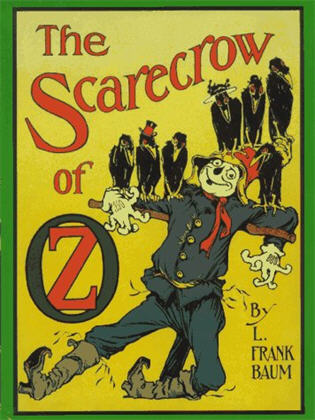
“Can you kill her love for the gardener’s boy?”
“Yes, your majesty: I can freeze her heart!”
Director: J. Farrell MacDonald
Starring: Violet MacMillan, Frank Moore, Pierre Couderc, Fred Woodward, Mai Wells, Raymond Russell, Vivian Reed, J. Charles Haydon, Todd Wright, Mildred Harris, Arthur Smollet
Screenplay: L. Frank Baum
Synopsis: King Krewl (Raymond Russell) tries to force his niece, the Princess Gloria (Vivian Reed), to marry Googly-goo (Arthur Smollet), a courtier, but she refuses, not least because she is secretly in love with Pon (Todd Wright), the gardener’s boy. Krewl sees the young couple embracing and angrily orders them to have no more to do with one another, but it is not long before he catches them kissing and decides that drastic action is required. In a cornfield, the Spirit Of The Corn materialises with her minions. They dance, and then the Spirit imbues a nearby scarecrow with life. Meanwhile, Dorothy (Violet MacMillan), a girl from Kansas, is captured and enslaved by the Wicked Witch, Mombi (Mai Wells). King Krewl places the recalcitrant Gloria under guard and marches her to the cottage of Mombi, begging the witch to help him. Not wanting witnesses, Krewl has Dorothy turned out of the cottage. There she encounters the frantic Pon, and the two of them look on in horror and distress as Mombi summons up her three witch-consorts. They brew a potion that Mombi uses to freeze Gloria’s heart, leaving her incapable of loving any mortal. Realising that Dorothy and Pon are spying on them, the witches give chase as the two run away. As the witches close in, Dorothy and Pon are saved by Hank the mule (Fred Woodward), who disperses the witches and chases Mombi back to her cottage. Left unattended at the cottage, Gloria wanders off, and finally encounters Dorothy and Pon. Pon declares his love for Gloria and pleads with her for a response, but she repulses him. Dorothy leads Pon away, trying to comfort him. They end up near the cornfield where, upon hearing calls for help, they meet the Scarecrow (Frank Moore). Helped down from his post, the Scarecrow immediately falls in love with Gloria, but she is unmoved by his declarations. Dorothy and Pon see an enraged Mombi approaching, and run away to hide. Mombi takes her temper out on the Scarecrow, ripping the straw from his body and shaking him violently. Once Mombi has gone, Dorothy and Pon manage to put the Scarecrow back together; he is none the worse for his ordeal. On the road, the travellers meet Button-Bright (Mildred Harris), a sailor boy who is lost and doesn’t care. They also discover the Tin Castle of the Tin Woodman (Pierre Couderc), who stands rusted and motionless until Dorothy oils him. No sooner has she done so than Mombi catches up with her adversaries. The Tin Woodman sends his new friends into his Castle, and turns with axe in hand to confront the witch…
Comments: Unlike its brethren, His Majesty, The Scarecrow Of Oz was not adapted for the screen by Frank Baum from one of his novels, but was filmed instead from an original screenplay. Baum used the production of this film to try out ideas he was still mentally shaping for his next Oz novel, hoping that the film’s success would act as a promotional boost for The Scarecrow Of Oz, which would not be published until the following year. In this, as in so much else, Baum was destined for disappointment.


His Majesty, The Scarecrow Of Oz differs from its fellows in another critical way, namely that it is the only release of The Oz Film Manufacturing Company that today survives in its entirety—or very nearly so. The film was almost another silent casualty; the opening reel was lost for many years, and the intertitles were lost altogether. A restoration of sorts was carried out in the 1960s, when the missing footage was located.
Chicago-based artist Dickinson Martin, the illustrator of a number of the post-Baum Oz novels, designed a new title card and new intertitles for the film; but although these are very much in the Baum tradition, they are not without error, mistakenly attributing the direction of the film to Frank Baum as well as the screenplay. My own suspicion is that there is a second error, as well: the credits now have Frank Moore (Unc Nunkie in The Patchwork Girl Of Oz and the ferryman – I think – in The Magic Cloak Of Oz) playing the Scarecrow and Pierre Couderc playing the Tin Woodman. However, comparing the Scarecrow of this film with the Patchwork Girl of her film, both performances as broadly physical as humanly possible, surely it has to be the same man under the makeup?
The other restored credit that catches my eye is the bald statement, Animals…Fred Woodward. While I may have my doubts about this film series as a whole, I confess that I have come to feel considerable affection and admiration for the ubiquitous Mr Woodward, whose ability to convey distinct personalities from within an endless succession of pantomime suits is truly remarkable. He even manages to differentiate the mules!


That Frank Baum used this film to try out some fragmentary ideas for a novel is exactly reflected in what ended up on the screen: His Majesty, The Scarecrow Of Oz is episodic even by the distinctly picaresque tradition of Baum’s writing. Characters wander around to no particular purpose, bumping into other characters, Oz and non-Oz, who appear and disappear with no introduction and little more explanation.
In fact, this film plays very much like a love letter to the Baum-o-philes out there; conversely, you probably don’t want to come to it as a Baum neophyte. Nor does it help – and I have no idea whether this is another artefact of an imperfect restoration or not – that the film as a whole seems grossly under-titled. Conversations go on for entire scenes, without the audience ever being given so much as a hint as to what might be the topic under discussion; perhaps we’re meant to know that, too.
Still, if you can accept the complete lack of any structure or logic to what’s thrown on the screen, there is plenty to enjoy in His Majesty, The Scarecrow Of Oz. Much more so than its predecessors, this film captures the both the whimsy and the ghoulishness of Oz, a land where nothing is odd because everything is odd, and where a gruesome fate lurks around every corner. The novels, thank heaven, were written at a time when children were allowed to be exposed to a little horror, without being expected to suffer lifetime psychological scarring as a consequence; not just be exposed to it, but even to revel in it.
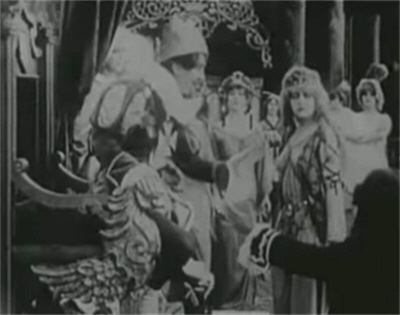

(Speaking for myself, I devoured the Oz novels at an early age, and subsequently speak many horridly enjoyable hours tormenting myself with mental images of the Nome King slicing his enemies into thin slices, and trying to solve the knotty problem of – ulp! – which direction he did it in…)
His Majesty, The Scarecrow Of Oz is essentially a reworked version of The Wonderful Wizard Of Oz, with Dorothy first arriving in Oz, the Scarecrow coming to life, the Tin Woodman found rusted, and so on; although it also features some significant revisions. The film opens with King Krewl trying to force his niece, Princess Gloria, to accept the hand of a courtier named Googly-goo, who offers Krewl a pile of jewels and pearls in exchange for the girl. Because this is Oz, the mere fact that an aspiring suitor is called “Googly-goo” is not considered good and sufficient reason for a girl’s refusal; and, sure enough, Gloria has another: she secretly loves Pon, the gardener’s boy.
Pon returns Gloria’s affection, as Krewl soon discovers, the two of them being a trifle indiscreet in the expression of their mutual passion: choosing the area immediately outside the Royal French Windows for an embrace seems somewhat less than wise! Krewl is outraged by the situation, and after Gloria flatly refuses to give up her “base-born lover” – a very un-Baum-like phrase, surely added during the restoration – he decides to seek outside assistance.
(In the novel Baum would eventually write, Pon would be of royal descent himself, though still banished through circumstance to the garden. I prefer this more egalitarian version.)

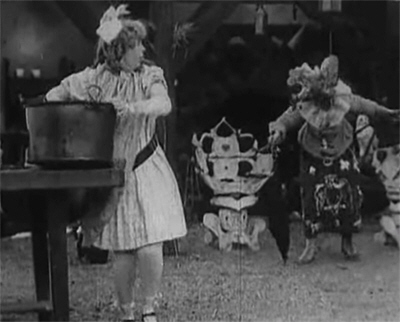
Two cutaways then set up our soon-to-be intersecting storylines. Two people we will never see again go into a cornfield and put together a scarecrow; and shortly afterwards, the “Spirit Of The Corn” – a completely stereotypical Native American, feather in the headband and whoo-whoo-whoo dancing and all – materialises with her followers. They dance, and the Spirit brings the Scarecrow to life…and then de-materialises again, leaving him hanging on his post.
Meanwhile, Dorothy is in Oz. Her distress and confusion indicate that her arrival was unplanned, also that she hasn’t been there before, but we are given no indication of how it all happened. Dorothy has barely landed when she falls foul of Mombi, the Wicked Witch – whose appearance here is based upon the work of W.W. Denslow, Baum’s first illustrator – and is hauled away to her cottage to…do housework.
(Along with Frank Baum’s mule fetish, these films reveal an amusing preoccupation with dreary domestic realities. One wonders if the Baums had a history of servant problems.)
Busy scrubbing away, Dorothy is turned out of the cottage when Krewl arrives with Gloria. Outside she finds Pon, and the two watch through the windows as Mombi gets down to business.

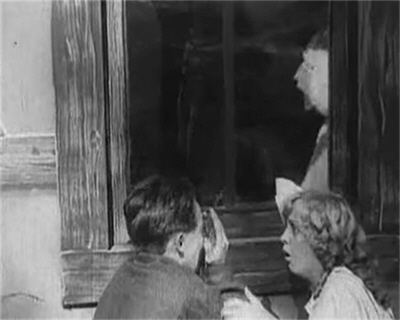
In order to brew her potion, Mombi first summons up her “band of witches”, three other women expressing various degrees of witchiness. One is dressed more or less in peasant clothing, but has a hunchback and carries the classic flying broom; one is your storybook witch, black cloak, pointy hat, the works (she probably has a wart); while the third is dressed in an hilarious costume that makes her look a great deal more like Batwoman than Batwoman ever did.
Each of the four witches throws an ingredient into the cauldron, and then, to complete the incantation, Mombi turns her collaborators into – cute chicks!? – who dance enthusiastically around the cauldron as Mombi gets to work on Gloria.
(With this following hard on the Spirit Of The Corn and her equally cute chorus line, His Majesty, The Scarecrow Of Oz reveals a certain ambivalence about what audience it was intended for.)
Mombi pours her potion over Gloria’s chest, then cups her hand. Gloria’s heart emerges and materialises in Mombi’s grasp, and icicles grow all over it. Mombi replaces the frozen organ, and cackles triumphantly. She returns the other witches to their real forms, and the four of them dance around the cauldron some more until they suddenly become aware that they are being spied on.
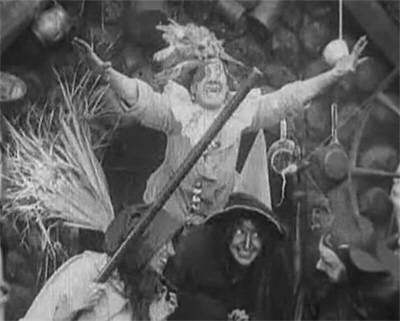
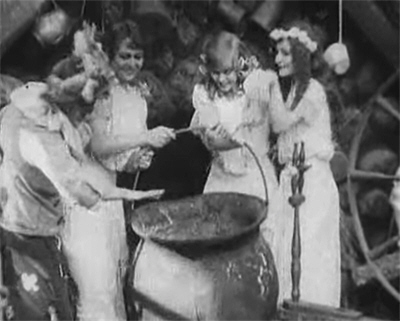
Dorothy and Pon run away with the witches in hot pursuit. Disaster strikes when—-no, you guessed wrong: it’s Pon who trips! – although he doesn’t sprain his ankle. Our heroes are saved, however, by the appearance of Hank the mule (presumably Dorothy’s mule from Kansas) who, after some rapid instruction from Dorothy, blocks the witches’ path and then enters into battle with them. Hank takes a beating here but emerges triumphant: the two witches with brooms fly off on them, and Batwoman flaps her wings; Mombi angrily combats the mule a little longer, but Hank sees her off, too, at least temporarily.
(It is this footage that shows up inexplicably in The Magic Cloak Of Oz.)
Meanwhile, Gloria has wandered out of the cottage, and is watching the action in a disinterested way: something she will continue to do until the end of the film, and which has an unfortunate impact upon the film. Gloria’s frozen heart evidently not just prevents her from loving, but from feeling anything at all. The other characters find this sad and tragic, but the effect upon the viewer is a bit different. Gloria will tag along with the others throughout, wearing an expression less indicative of a frozen heart than of extreme boredom. This may just be Vivian Reed’s incapacity as an actress showing, but when a character seems to find its own story so very dull, it is hard for those watching not to be a little influenced.
Gloria wanders off again, and after a moment Hank follows her. (Ever seen a mule scratch its head in bemusement? You will here.) The two catch up with Dorothy and Pon at a well. Pon tries desperately to win a response from his frozen lover, but she pushes him away. Dorothy leads the stricken Pon away, and they end up on the edge of a cornfield where they hear cries for help. They help the Scarecrow down, and he joins them in their travels…whatever those are.
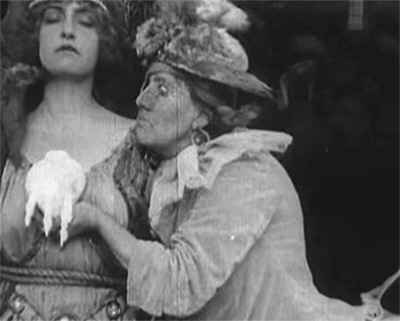
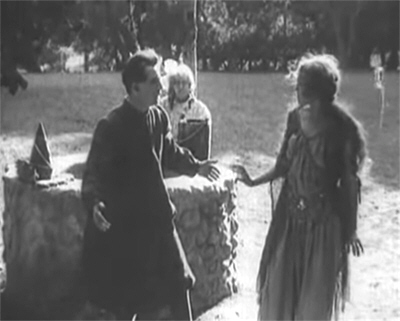
Here the complete absence of any motivation for the characters makes itself painfully obvious: they’re not going anywhere, or searching for anything in particular; not, for example, looking for someone who can unfreeze Gloria; they just wander around aimlessly, encountering people or avoiding Mombi (and we never learn why she’s so angry with them, or keeps pursuing them, either), until the film reaches a proper running-time.
Mombi catches up with her adversaries here, and gets her hands on the Scarecrow, ripping out his straw stuffing and very nearly tearing his head off in an alarming sequence. Fortunately, Hank reappears and again battles Mombi, as Dorothy and Pon, who have watched all this in horror, manage to reassemble their disembowelled friend.
The next encounter is with Button-Bright (played by Mildred Harris in this film’s inevitable gender-switch), a sailor boy who declares, “I’m lost, I don’t know where I came from, and I don’t care.” In the novels, Button-Bright is a forerunner of sorts to Jerzy Kosiński’s Chauncey Gardiner, forever being declared a genius chiefly because he thinks nothing at all. This is not a joke that translates well to a silent film – not that they really tried – with the result that we now have two blank and disinterested characters attached to the story.


Fortunately, the travellers next come across the Tin Woodman, rusted beneath a tree with his axe perpetually raised. (Although this seems to be the first appearance of the Tin Woodman, his Tin Castle suggests he is already the Emperor of the Winkies.) Dorothy oils him and brings him back to life, and just in time: Mombi catches up again. The Tin Woodman ushers his new friends into his castle, and turns to confront the witch with axe in hand. Mombi threatens the Tin Woodman, angrily decrying his interference, and the Tin Woodman…chops her head off.
The mechanics of this scene are perhaps a little too obvious for it to as disturbing as it could have been, but this is still a fairly startling moment. However, decapitation barely hinders Mombi. She simply feels around until she finds her head, and puts it back on. By this time the Tin Woodman has gone inside, and the disgruntled Mombi is wandering off when Pon and Gloria choose exactly the wrong moment to wander in…and Mombi turns Pon into a kangaroo.
As you do. And really, it’s all for the best, because Pon-the-roo is played by Fred Woodward…
I can’t let this sequence pass without astonished recognition of the Tin Woodman’s costume in this film, which is not only much worse than the one in The Wonderful Wizard Of Oz, but worse than you’d find in your average school production of the story. It isn’t just the way that his “metal” panels wobble and flap; but that material they used at his joints— Yes, I’m sure it’s meant to be chain-mail; but far too obviously, it isn’t; giving us a Tin Woodman who wears saggy polka-dot underwear.




There’s a brief insert here featuring the Cowardly Lion and the Lonesome Zoop (re-used footage from The Magic Cloak Of Oz), and then it’s back to the Castle, where the Tin Woodman lays eyes upon Gloria, and instantly falls in love with her, as the Scarecrow did earlier. Now, since, strictly speaking, neither the Scarecrow nor the Tin Woodman is mortal, by the terms of Mombi’s spell Gloria ought to be able to respond to them, at least; but she just looks bored as always. Pon-the-roo wanders up in the middle of the Tin Woodman’s impassioned declaration and expresses his displeasure, but the Woodman sees him off with a wave of his axe.
Dorothy then explains Gloria’s situation; a situation that, I must point out, gives a remarkable number of people an excuse, over the course of the film, to press their hands or their ears against her chest (moments not made any more comfortable by the fact that Vivian Reed is clearly not wearing a bra). The Tin Woodman is so indignant, he proposes overthrowing King Krewl and making Gloria ruler in his place; and at long last our characters have an actual motivation. Hurrah!
But obviously I’m wrong about this film being complete, because the next thing we know our conquering army – some of it; Gloria and Pon aren’t there – is making its escape on a raft poled by the Scarecrow, as Mombi shakes an impotently angry fist from the safety of the bank (water, you understand). In the middle of the river, the pole gets stuck, with the Scarecrow still attached to it; and we get a rather charming underwater interlude as he encounters first something like a swordfish, and then a flirtatious mermaid (with an umbrella; don’t ask me).
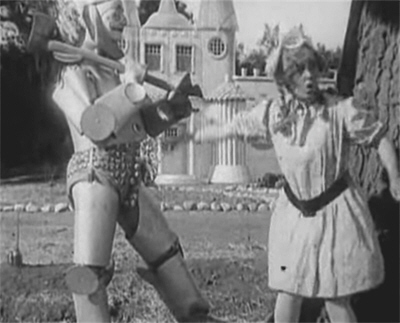

The Scarecrow is finally rescued by the Friendly Crow, and deposited on land with his companions. Rescuer and rescuee – Crow and Scarecrow – seem a little uncertain of one another, but soon they shake hands and do a little dance; but maybe I’m missing something here, because the Scarecrow’s friends end up chasing the Crow away. What!? Next up we meet a Cow, who the travellers try to milk (I wonder how Fred Woodward felt about that?), but it registers an understandable protest and after some tussling is allowed to run away.
Then it’s back to the raft, and up and over the Wall Of Water – a surprisingly effective sequence, realised through nothing more complicated than tilting the camera and shifting the characters – and then, upon landing, there is a meeting with the Wizard Of Oz, who is travelling in a carriage drawn by the saw-horse. Curiously, everyone here seems to know everyone else!? – and much delighted hand-shaking follows. The Wizard helps his friends up a ladder and into his carriage, just as the fuming Mombi appears (and how, exactly, did she get there?).
Mombi begins climbing up the ladder too, as the Wizard guides everyone else out his carriage’s handy back door. The Wizard then shuts the door and removes the ladder, and drives off with Mombi trapped. Further down the road, he lets her out. Mombi evinces fear of the Wizard and, as it turns out, rightly so. The Wizard embiggens a can of “preserved sandwitches” (yes, spelled like that), and traps Mombi inside it before making a few alterations to the label… He then shrinks the can again and drives off with the witch in his pocket.


Meanwhile, the Scarecrow and the Tin Woodman stumble over the Cowardly Lion, and introduce Dorothy and Button-Bright to him. Elsewhere, Gloria and Pon are still wandering around pointlessly, and they wander straight into King Krewl and his soldiers. Googly-goo throws himself at Gloria’s feet and starts kissing her hand, and Pon responds by giving him a thorough kangaroo kicking. He also attacks Krewl before being chased off by the soldiers, and Gloria is captured and carried into Krewl’s castle.
The others catch up at this point, and follow the soldiers to the castle. A mighty [sic.] battles ensues, with the soldiers waving their spears over the ramparts, and Dorothy and Button-Bright throwing stones at them from down below. And then something truly odd happens: Gloria becomes distressed by the situation. Whuh?? I don’t know why this, of all things, should break through her enchantment, but so it is. Wringing her hands, she slips away from her spear-waving companions and unfurls the rope-ladder that just happens to be up on the ramparts with them.
Dorothy, obviously the tactical genius of the team, sends the essentially undamageable Tin Woodman and Scarecrow up the ladder, while she and Button-Bright continue to distract the soldiers. The soldiers finally start firing arrows, but this has no effect on the Scarecrow (luckily this crew isn’t smart enough to think about burning arrows), and he climbs up onto the roof, looking rather like St Sebastian. The soldiers are so freaked out by this, they immediately surrender. The others climb up the ladder and, as Button-Bright plucks arrows from the Scarecrow, Dorothy relieves Krewl of his crown, declaring that the Scarecrow should be the new king. “Hooray for King Scarecrow!” say the soldiers, or words to that effect – suggestible is putting it mildly – and then put Krewl and Googly-goo under arrest.
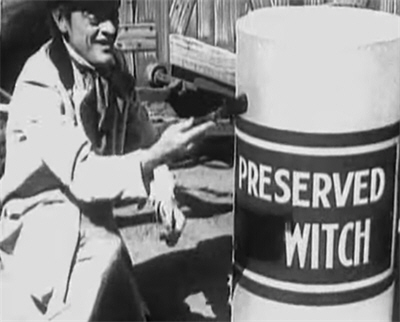
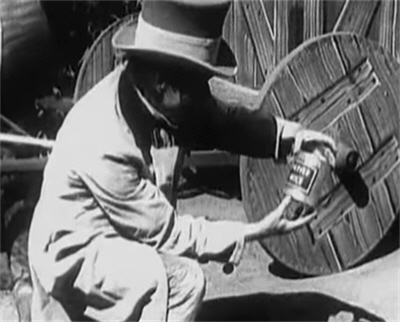
Meanwhile, the Cowardly Lion is learning one of life’s cruellest lessons: pantomime animals cannot climb rope-ladders.
His Majesty, the Scarecrow, Conqueror of the mighty King Krewl, declares an intertitle, and rarely have so many inaccuracies been expressed in so few words. Gloria has reverted to pouting disinterest, and looks on with glazy eyes as the Scarecrow assumes her uncle’s throne. Pon bounces in and starts kissing Gloria’s hand – and scratching himself – but this doesn’t get a reaction from her either.
The Wizard then shows up, flourishing Mombi-In-A-Can. Re-embiggening both the can and the witch, he promises to let her out if she promises to undo her enchantment, to which she grumblingly agrees. Mombi summons her witch-accomplices, extracts Gloria’s frozen heart, melts it and replaces it. The witches vanish, while Gloria immediately starts clasping her hands and fluttering her eyelashes to let us know she’s a proper feeling girl again—and then realises that she’s engaged to a macropod. Personally, I wouldn’t have a problem with that, but Gloria appeals to the Wizard, who re-transforms Pon into a gardener’s boy.
Two guards then drag in Googly-goo, who throws himself at the Scarecrow’s feet and begs for mercy. The Scarecrow refers him to Gloria, and she commands that he be taken away and executed! How’s that for a heart-warming ending?


Proving that there’s no satisfying some people, I almost have to complain that His Majesty, The Scarecrow Of Oz has too much story. Still, if the film is over-stuffed and confusing and frequently under-motivated, at least it’s rarely dull; and while it’s best suited to those who know their Baum, as long as you don’t mind its unexplained flourishes, you’ll probably have a good time with it whatever your level of Oz-savvy. The special effects are rudimentary but effective, and the performances all reasonably good. The Scarecrow – whoever it is under the makeup – flails and falls rather too much for my liking, but that’s a matter of personal taste.
On the other hand, the scenes with Mombi and her witch homies are a hoot. These scenes are my favourites chiefly because everyone involved, particularly the storybook witch, is so obviously getting such a kick out of their participation.
Meanwhile, all of the by-now familiar faces are back again. Following on from The Magic Cloak Of Oz, Violet MacMillan and Mildred Harris swap gender duties (amusingly, Miss MacMillan is a lot less effeminate playing Dorothy here than she was playing Ojo in The Patchwork Girl Of Oz). Vivian Reed gets promoted from minstrel to princess; Mai Wells, previously Aunt Rivette, gets nasty again as Mombi; Raymond Russell is King Krewl; while we must offer a special bouquet to Fred Woodward, who outdoes himself in this one. In particular, there is an hilarious bit of business when Pon-the-roo finds the Tin Woodman kneeling before Gloria, making her an impassioned declaration, and reacts by smacking his romantic rival on the back of the head with one of his enormous roo-feet.
(In fact I think the kangaroo here is my favourite of Woodward’s characters, or at least equal first with the Woozy.)


The most interesting piece of casting, however, involves a newcomer. J. Charles Haydon, who plays the Wizard, was like many at the time a director and a writer as well as an actor; and in 1920, he would be responsible for the production of an exceedingly strange version of Dr Jekyll And Mr Hyde.
His Majesty, The Scarecrow Of Oz received a cinema release in October of 1914; but while it was well-received by the critics, it was not so by the paying public. The film was released again early in 1915, under the title The New Wizard Of Oz, and it did a little better; but it never came near to recovering its costs.
This was a crippling blow for The Oz Film Manufacturing Company, but Baum and his companions battled on for a time. In December of 1914 they released another feature-film, The Last Egyptian, based upon an adult novel that Baum originally published anonymously (a film which apparently featured Fred Woodward in a non-suit role!): only three of the film’s five reels still survive, and they are now held by MOMA. The company also made Violet’s Dreams, a series of short films for children featuring Violet MacMillan, at least one of which she also directed.
Finally, in 1915, The Oz Film Manufacturing Company changed its name to Dramatic Feature Films, and control was ceded to Frank Baum’s eldest son, who until then had been in charge of the east coast distribution of his father’s films. This version of the company made only two films, one a comedy short and the other a WWI-set romantic drama. The latter was unable to secure distribution, and Dramatic Feature films folded soon after, its studio space being sold to Universal Pictures, located just down the road.


Frank Baum did not lose money over the crumbling of his film-making enterprise, simply because he had not invested any: instead, he accepted a large block of the company’s stock in exchange for the rights to his stories. Baum’s three partners, on the other hand, did lose a bundle; and that knowledge on top of his latest business failure dealt a blow to Baum’s health from which he never fully recovered. He never stopped writing, however, and completed five more Oz novels before his death in 1919.
While his novels have never lost their popularity, it was MGM’s 1939 version of The Wizard Of Oz that put the seal upon Frank Baum’s legacy. Ironically, the failure of Baum’s own films had his Oz stories declared box-office poison; and it was another decade before anyone again attempted to bring them to the screen…and even then, did so in form so bizarre and disturbing, it would take a full fifty years before anyone else managed to outdo it…


I ♥ Fred Woodward

These reviews of the early Oz films are what motivated me to finding and watching them so I have to thank you for that. All I knew about them before was the occasional vague reference to it being a common attitude that Oz = box office poison when the Judy Garland one was being produced. The Larry Semon one has got to be the most bizarre one ever made and I have to wonder what he was thinking when he made it. Of all the Oz movies it’s Return To Oz that’s my favorite. It was a gutsy move making that one fairly true to the books rather than attempting to follow the style of the musical which is what almost everyone thinks of when you mention Oz.
LikeLike
Yes, there was more of a solid basis for that attitude than is realised these days.
I was hoping to get the Larry Semon version up within the date-range of the Roundtable, since “WTF!?” is pretty much the only sane response to it, but time got tight. Still, it may show up over the next few days…
There’s so much material in the novels that has never been touched: an ongoing series might be the only way to do them justice (and these days you wouldn’t have to soft-pedal the horror aspects, speaking of RtO).
LikeLike
Pingback: The Myth of Oz | Klaus Kreimeier